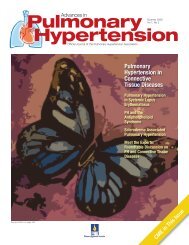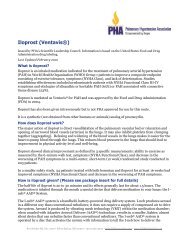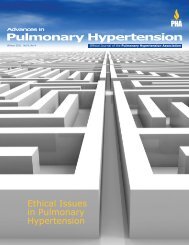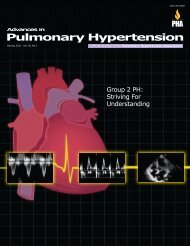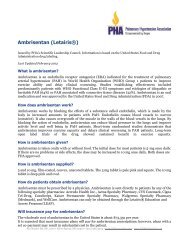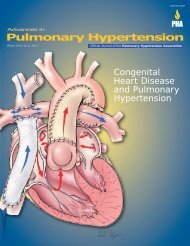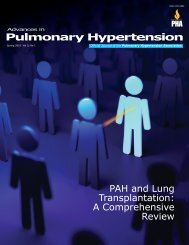Vol 7, No 3 - PHA Online University
Vol 7, No 3 - PHA Online University
Vol 7, No 3 - PHA Online University
You also want an ePaper? Increase the reach of your titles
YUMPU automatically turns print PDFs into web optimized ePapers that Google loves.
Connective Tissue Disease-Associated<br />
Pulmonary Hypertension<br />
Christopher P. Denton PhD, FRCP<br />
Professor of Experimental Rheumatology<br />
Royal Free Campus, <strong>University</strong> College London<br />
Head of Scleroderma Service, Royal Free Hospital<br />
London, UK<br />
I was very excited to see a whole issue of Advances in Pulmonary<br />
Hypertension (<strong>Vol</strong>. 7, <strong>No</strong>. 2, Summer 2008) devoted to<br />
connective tissue disease associated pulmonary hypertension<br />
(PH). As a practicing rheumatologist in a center that manages<br />
a large cohort of more than 1000 scleroderma cases, and a<br />
center that benefits from having a pulmonary hypertension centre<br />
embedded within it, all of the topics covered in this issue<br />
were very relevant.<br />
Scleroderma has the highest frequency of pulmonary hypertension<br />
of any of the rheumatic disease and is especially challenging<br />
to manage as cases often have co-morbidity that affects<br />
assessment and may lead to poor outcome. There are also particular<br />
challenges for diagnosis and assessment. All of these<br />
points were highlighted and I was especially pleased to see the<br />
emphasis that was put on autoantibodies as useful tests is<br />
assessing risk of developing pulmonary arterial hypertension<br />
(PAH) in scleroderma. Less invasive tests focused on at-risk<br />
Address for reprints and other correspondence: Christopher P. Denton, PhD<br />
FRCP, Professor of Experimental Rheumatology, Centre for Rheumatology,<br />
Royal Free Hospital, London,NW3 2QG. email: denton@rfhsm.ac.uk<br />
groups will be essential for timely detection and treatment of<br />
PAH in connective tissue disease.<br />
Scleroderma and the antiphospholipid syndromes were<br />
very clearly reviewed and the articles offered clear insight into<br />
the likely differences in frequency of PAH in these diseases<br />
and also the potential contribution of thrombosis to contribute.<br />
Being mindful of pathogenic mechanisms is likely to underpin<br />
better therapy in connective tissue disease associated<br />
pulmonary hypertension. One of the challenges faced daily in<br />
managing connective tissue disease associated PAH is the<br />
co-existence of interstitial lung fibrosis. The degree to which<br />
many patients should have PAH or PH secondary to lung fibrosis<br />
remains a topic of considerable debate and I was interested<br />
to see how this challenge was tackled in some of the major<br />
centres in the USA.<br />
Without doubt, the most engaging and relevant part of this<br />
excellent issue was the round table discussion. Almost all of<br />
the important points raised are as relevant to practice in the<br />
UK and other European centres as they are in USA. It is clear<br />
from the answers to many key questions that this whole topic<br />
requires more research and better information. However, with<br />
exciting projects such as <strong>PHA</strong>ROS for scleroderma and complementary<br />
exercises ongoing in Europe, I was left with optimism<br />
about clinical practice for patients with connective tissue disease-associated<br />
pulmonary hypertension, even if the outcomes<br />
for many patients do not seem to be as good as in idiopathic<br />
PAH.<br />
In conclusion, there are more similarities than differences<br />
in the approach to PAH in Europe and the USA based upon<br />
these articles. This is a testament to the strong international<br />
collaboration in clinical trials and educational programs that<br />
exist in the fields of connective tissue disease and pulmonary<br />
hypertension.



